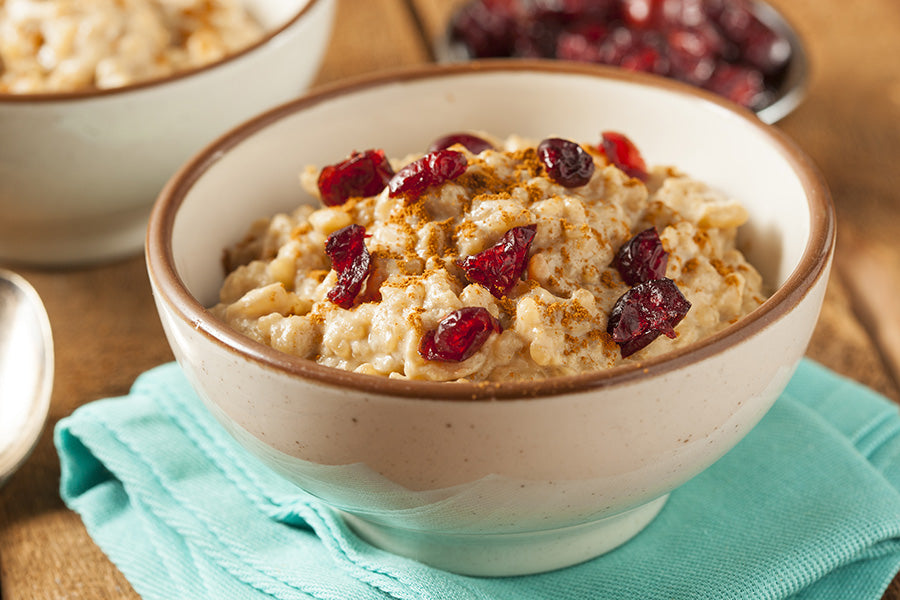Are you tired of the same old boring breakfast routine? Do you long for a delicious and nutritious meal that will give you the energy you need to tackle the day ahead? Well, look no further than high-protein brown rice pudding!
This creamy, dreamy breakfast treat is the perfect combination of wholesome and indulgent. It's made with hearty brown rice packed with fiber and essential nutrients and then laced with a generous amount of protein powder to give you that extra boost of energy. And the best part? It's so delicious. You won't even realize you're eating something healthy!
Imagine waking up to the aroma of sweet flavors and cinnamon wafting through your kitchen. As you take your first bite of warm, gooey brown rice pudding, you're transported to a place of pure bliss. The chewy texture of the rice mixed with the creamy, velvety pudding creates a symphony of flavors and textures that dance on your taste buds.
Not only is this high-protein brown rice pudding a delicious way to start your day, but it's also incredibly versatile. You can top it with fresh fruit, nuts, or a drizzle of honey to customize it to your liking. It's a meal that's as fun to make as it is to eat, and once you try it, you'll wonder how you ever lived without it.
So why settle for a boring bowl of cereal when you can indulge in a high-protein brown rice pudding that will leave you feeling satisfied and energized? Give it a try, and you'll be hooked!
Related Article: 10 Best High Protein Breakfasts for Muscle Growth
|
Servings |
4 Persons |
|
Preparation Time |
5 Minutes |
|
Cooking Time |
25 Minutes |
|
Total Time |
30 Minutes |
Nutritional Facts
|
Calories |
244 cal |
|
Protein |
18 g |
|
Carbs |
26 g |
|
Fat |
7 g |
Ingredients
- 2 cups cooked brown rice
- 2 cups unsweetened almond milk
- ½ cup protein powder, any flavor
- 2 tbsp reduced-fat butter
- 1 tsp ground cinnamon
- 1 tsp pure vanilla extract Stevia, optional
- Raisins, optional
- Whipped topping, optional
Instructions
- Combine the cooked brown rice, almond milk, butter, cinnamon, and vanilla essence in a medium pot.
- Set over medium-low heat and slowly simmer. Reduce the heat to low once the mixture has simmered for about 7 to 10 minutes or until the liquid thickens.
- Add the remaining milk, protein powder, and perhaps a few drops of liquid stevia. Over low heat, mix constantly for 10 to 12 minutes or until thick and creamy.
- Turn off the heat and blend for an additional two to three minutes. Let the mixture cool for 20 minutes.
- Place in the refrigerator or serve warm.
Brown Rice Vs. White Rice: Which Is a Healthy Option?

With its versatility, rice is a grain that's enjoyed by people all over the world as a staple food. This holds true, particularly in China, Japan, India, Indonesia, and South Korea.
Interestingly, there are more than 7,000 varieties of rice available in various colors, shapes, and sizes. White and brown rice is the most commonly consumed in the United States. Despite being the more popular choice, white rice has a healthier counterpart in brown rice which is becoming increasingly favored.
Difference Between Both Rice
Carbohydrates comprise a significant portion of all rice varieties, with minimal protein and fat content.
Nevertheless, brown rice is classified as a whole grain containing fibrous bran, nutrient-rich germ, and carb-rich endosperm. Due to its tough exterior, it has a chewy texture and takes longer to cook.
Alternatively, white rice has gone through the process of having its bran and germ removed. White rice is left with few vital nutrients since these are the most nourishing parts of the grain. It is a softer texture and tends to cook faster than brown rice.
Brown Rice Benefits
Brown rice is a highly nutritious grain that has many health benefits. Here are some of the key benefits of consuming brown rice:
Nutrient Rich
Although brown rice's nutrient content surpasses white rice's, the advantage is not significant. Brown rice has a higher amount of fiber, antioxidants, vitamins, and minerals.
For instance, 100 grams (3.5 ounces) of cooked brown rice contain 1.6 grams of fiber compared to only 0.4 grams of fiber found in 100 grams (3.5 ounces) of white rice.
Positive Effects on Blood Sugar Levels
One of the benefits of consuming brown rice is its high magnesium and fiber content, which help regulate blood sugar levels. Eating whole grains like brown rice has been found to lower blood sugar levels and decrease the risk of type 2 diabetes. Replacing white rice with brown has also been shown to have similar effects.
Conversely, high amounts of white rice have been linked to an increased risk of diabetes due to its high glycemic index (GI). White rice has a GI of about 89, much higher than brown rice's GI of about 50. However, white rice can be cooled after boiling to form resistant starch, which lowers its GI and functions similarly to soluble fiber.
Additionally, combining rice with vinegar or oil can further reduce its GI. If looking for alternative rice varieties, consider basmati, red, black, or wild rice, which all have lower GIs than white rice.
Related Article: 15 Best Foods to Lower High Blood Sugar
Reduce Heart Disease Risk
Research indicates that consuming brown rice may help reduce risk factors associated with heart disease.
A comprehensive analysis of 45 studies revealed that individuals who consumed the most whole grains, including brown rice, had a lower risk of heart disease by 16-21% compared to those who consumed the fewest whole grains.
Additionally, whole grains like brown rice have been found to decrease total and LDL ("bad") cholesterol levels and even increase HDL ("good") cholesterol levels in some populations. However, these findings are not consistent across all groups.
Rich in Antioxidants
The bran of brown rice contains a host of potent antioxidants that can help counteract the effects of harmful free radical compounds and minimize inflammation in the body.
As a result, consuming whole grains like brown rice may play a role in reducing the risk of chronic illnesses such as heart disease, cancer, and type 2 diabetes due to their antioxidant content.
Aids Weight Control
Switching from white to brown rice may be a practical step toward weight loss and reducing the body mass index (BMI) in adults.
Individuals who consume more whole grains, such as brown rice, tend to have lower body weight, according to a study involving 29,683 adults and 15,280 children.
Furthermore, a randomized controlled trial conducted on 40 women with overweight and obesity found that consuming brown rice reduced body weight and waist circumference compared to eating white rice.
The Bottom Line
Healthy brown rice pudding is a delicious dessert and a nutritious and beneficial addition to one's diet.
With the numerous benefits of brown rice, such as weight loss, good blood pressure regulation, high antioxidant content, reduction in heart disease risk, and nutrient-rich properties, it's easy to see why incorporating it into meals is essential.
Not only does it improve overall health, but it also satisfies cravings for something sweet without compromising on nutrition. So why not trade in your regular pudding for a healthier option and experience the benefits of this superfood for yourself? Try it out today and feel the difference in your body!
Reading List
Morning Glory Yogurt Bowl: A Sweet & Nutritious Start to the Day
Best High Protein Churro Scones Recipe for Breakfast
How 2 Minutes of Walking After a Meal Can Lower Your Blood Sugar
Article Sources
- Albertson, Ann M., et al. "Whole Grain Consumption Trends and Associations with Body Weight Measures in the United States: Results from the Cross Sectional National Health and Nutrition Examination Survey 2001-2012." Nutrition Journal, vol. 15, no. 1, Jan. 2016, p. 8. BioMed Central, https://doi.org/10.1186/s12937-016-0126-4.
- Atkinson, Fiona S., et al. "International Tables of Glycemic Index and Glycemic Load Values 2021: A Systematic Review." The American Journal of Clinical Nutrition, vol. 114, no. 5, Nov. 2021, pp. 1625-32. PubMed, https://doi.org/10.1093/ajcn/nqab233.
- Aune, Dagfinn, et al. "Whole Grain Consumption and Risk of Cardiovascular Disease, Cancer, and All Cause and Cause Specific Mortality: Systematic Review and Dose-Response Meta-Analysis of Prospective Studies." BMJ, vol. 353, June 2016, p. i2716. www.bmj.com, https://doi.org/10.1136/bmj.i2716.
- Hu, Yang, et al. "Intake of Whole Grain Foods and Risk of Type 2 Diabetes: Results from Three Prospective Cohort Studies."The BMJ, vol. 370, July 2020, p. m2206. PubMed Central, https://doi.org/10.1136/bmj.m2206.
- Imam, Mustapha Umar, et al. "Increased Risk of Insulin Resistance in Rat Offsprings Exposed Prenatally to White Rice." Molecular Nutrition & Food Research, vol. 59, no. 1, Jan. 2015, pp. 180-84. PubMed, https://doi.org/10.1002/mnfr.201400396.
- Kaur, Bhupinder, et al. "The Glycemic Index of Rice and Rice Products: A Review, and Table of GI Values." Critical Reviews in Food Science and Nutrition, vol. 56, no. 2, 2016, pp. 215-36. PubMed, https://doi.org/10.1080/10408398.2012.717976.
- Kazemzadeh, Mahdieh, et al. "Effect of Brown Rice Consumption on Inflammatory Marker and Cardiovascular Risk Factors among Overweight and Obese Non-Menopausal Female Adults." International Journal of Preventive Medicine, vol. 5, no. 4, Apr. 2014, pp. 478-88.
- Min, Byungrok, et al. "Phytochemicals and Antioxidant Capacities in Rice Brans of Different Color." Journal of Food Science, vol. 76, no. 1, 2011, pp. C117-126. PubMed, https://doi.org/10.1111/j.1750-3841.2010.01929.x.
- Mohan, Viswanathan, et al. "Effect of Brown Rice, White Rice, and Brown Rice with Legumes on Blood Glucose and Insulin Responses in Overweight Asian Indians: A Randomized Controlled Trial." Diabetes Technology & Therapeutics, vol. 16, no. 5, May 2014, pp. 317-25. PubMed, https://doi.org/10.1089/dia.2013.0259.
- Ravichanthiran, Keneswary, et al. "Phytochemical Profile of Brown Rice and Its Nutrigenomic Implications." Antioxidants (Basel, Switzerland), vol. 7, no. 6, May 2018, p. 71. PubMed, https://doi.org/10.3390/antiox7060071.








